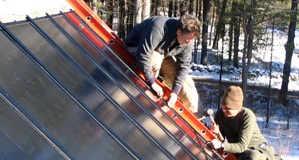Vermont's VPIRG starts Solar Community Program
 The Vermont Public Interest Research Group (VPIRG) is making it less expensive to install solar in Vermont through their recently launched Community Solar program. The program uses the power of collective or bulk purchasing to reduce the cost of PV. And VPIRG has a deal with the state’s largest solar developer to lower costs of owning a 5 kilowatt PV array to roughly $85 per month for a 10 year period—about $19 more than the average Vermonter’s current monthly electric bill or the equivalent of “a Starbucks a week,” explained VPIRG President and VPIRG Energy Co-Director, Duane Peterson.
The Vermont Public Interest Research Group (VPIRG) is making it less expensive to install solar in Vermont through their recently launched Community Solar program. The program uses the power of collective or bulk purchasing to reduce the cost of PV. And VPIRG has a deal with the state’s largest solar developer to lower costs of owning a 5 kilowatt PV array to roughly $85 per month for a 10 year period—about $19 more than the average Vermonter’s current monthly electric bill or the equivalent of “a Starbucks a week,” explained VPIRG President and VPIRG Energy Co-Director, Duane Peterson.
The initiative, launched last Thursday (Sept. 23), “already received 120 inquiries,” said Peterson. He said that the program was born of “our desire to increase solar energy production.” The first two communities that will participate are Williston and Waterbury.
“We operate an outreach campaign every summer where our organizers knock on 60,000 doors in Vermont,” he said. “And we heard a lot from our neighbors that they want electricity from renewable sources, but they have a lot of trouble as individuals figuring out how. So we wanted to help out.”
VPIRG applied a community organizing model to come up with this solution.
“We put out a competitive RFP [request for proposal] to the solar industry in Vermont, alerting them that we expected to generate a large volume of sales in close proximity,” he said. “What we can do is do the community organizing to generate interest and turn customer leads over to the [solar] installers.”
According to Peterson, VPIRG’s decision was weighted in three areas: quality of equipment, an installer’s ability to handle the volume, and price.
VPRIG chose Alteris Renewables.
“Typically, a business offers its best price to its own employees, and they offered solar community members their employee discount,” he said.
Under the program, participating homeowners will lease the solar panels for a 10-year period paying, as previously stated, roughly $85 a month after all the rebates and incentives are included. After that they will own the system outright. And since most solar panels are expected to generate for at least 25 years, that means at least 15 years of free electricity.
“We’re about to do a deal soon—we hope—with a bank that would offer a specific solar loan with discounted interest rates,” Peterson said.



